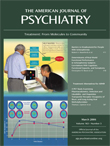Assessment of Therapeutic Misconception in Older Schizophrenia Patients With a Brief Instrument
Abstract
OBJECTIVE: “Therapeutic misconception,” or conflation of goals and procedures of clinical research with those of usual clinical care, is an important topic in research ethics because it may impede informed consent. How best to assess therapeutic misconception is unclear. Also unclear is to what degree patients with severe mental illnesses, such as schizophrenia, may manifest these beliefs. METHOD: With a hypothetical, double-blind, placebo-controlled trial as a stimulus, the authors examined the frequency of a key aspect of therapeutic misconception with a true/false scale in 87 middle-age and older patients with schizophrenia or schizoaffective disorder. They also analyzed the demographic, clinical, neurocognitive, and decision-making correlates of therapeutic misconception and examined the psychometric properties of a scale designed to measure therapeutic misconception. RESULTS: Subjects showed variable performance on the therapeutic misconception measure. Nearly one-third answered all questions correctly; two-thirds answered four or more of the six items correctly. Patients with less education or worse cognitive functioning manifested higher levels of therapeutic misconception. Degree of therapeutic misconception was inversely associated with understanding, appreciation, and reasoning scores on the MacArthur Competence Assessment Tool for Clinical Research but was not associated with severity of psychopathology. The scale showed fair internal consistency. CONCLUSIONS: As in studies of other patient populations, patients with schizophrenia show a substantial incidence of beliefs associated with therapeutic misconception. Further work should focus on refining measures of therapeutic misconception, identifying participants or protocols (e.g., higher-risk studies) in which it may warrant greater concern, and developing educational interventions to mitigate it.



